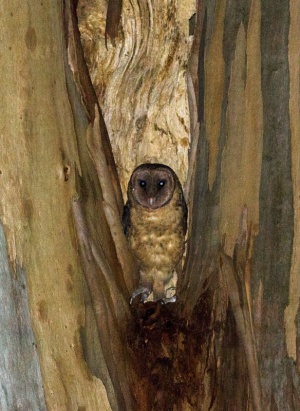- Tyto novaehollandiae
Includes: Tasmanian Masked-Owl
Identification
35-47cm
- White facial disk
- Short brown feathers around dark brown or black eyes
- Upperparts blackish brown with grey and white spots
- Underparts white with brown spots
Female: similar but rather darker
Distribution
Australia and extreme southeast New Guinea.
Taxonomy
Subspecies[1]
- T. n. calabyi:
- Trans-Fly lowlands of southern New Guinea and Daru Island
- T. n. melvillensis:
- Northern Australia (Melville Island and Bathurst Island)
- T. n. galei:
- North-eastern Queensland (north-eastern Cape York Peninsula)
- T. n. kimberli:
- Northern Australia (Yampi Peninsula to Atherton Tableland)
- T. n. novaehollandiae (perplexa):
- South-western Western Australia to Victoria and north-eastern Queensland (Townsville)
- T. n. castanops:
- Tasmania, Maria Island and Maatsuyker Island - sometimes accepted as full species, Tasmanian Masked-Owl
Habitat
Open forests.
Behaviour
Nocturnal.
Diet
They have a varied diet which includes rodents, reptiles, birds, insects and small mammals such as bandicoots.
Breeding
The usual nest site is in a tree hole lined with sand or soil. Two or three eggs are laid and are incubated by the female.
References
- Clements, JF. 2008. The Clements Checklist of Birds of the World. 6th ed., with updates to December 2008. Ithaca: Cornell Univ. Press. ISBN 978-0801445019.
- Wikipedia
Recommended Citation
- BirdForum Opus contributors. (2025) Australian Masked Owl. In: BirdForum, the forum for wild birds and birding. Retrieved 9 May 2025 from https://www.birdforum.net/opus/Australian_Masked_Owl
External Links
GSearch checked for 2020 platform.





